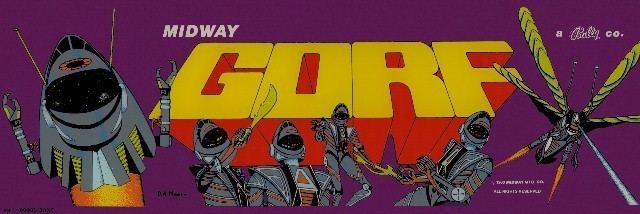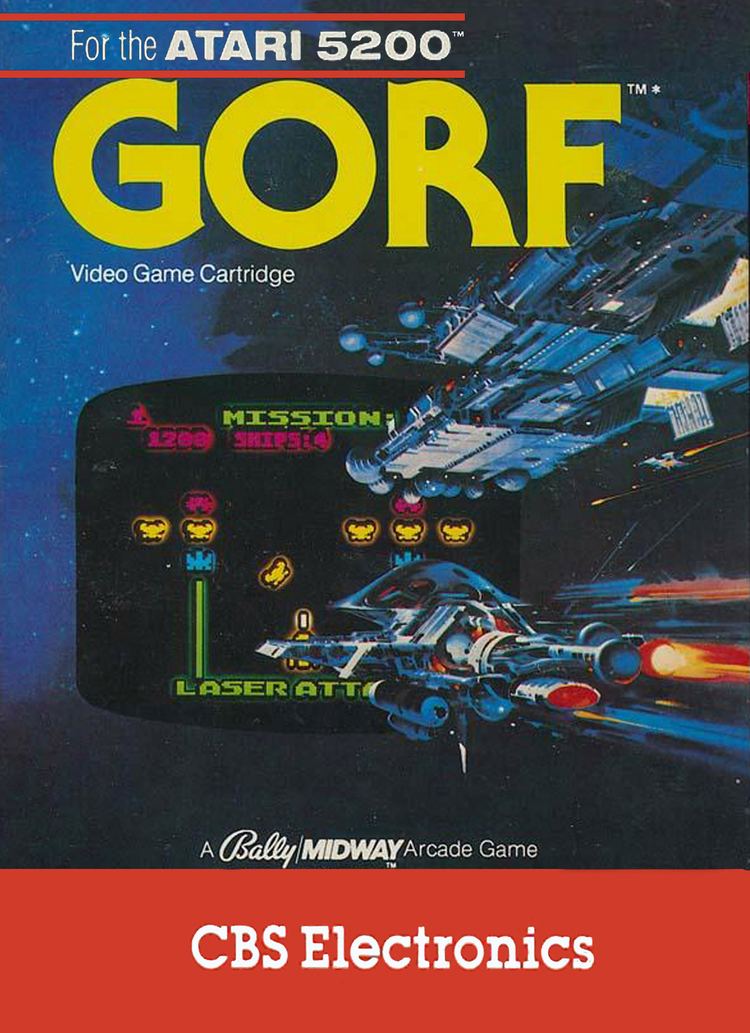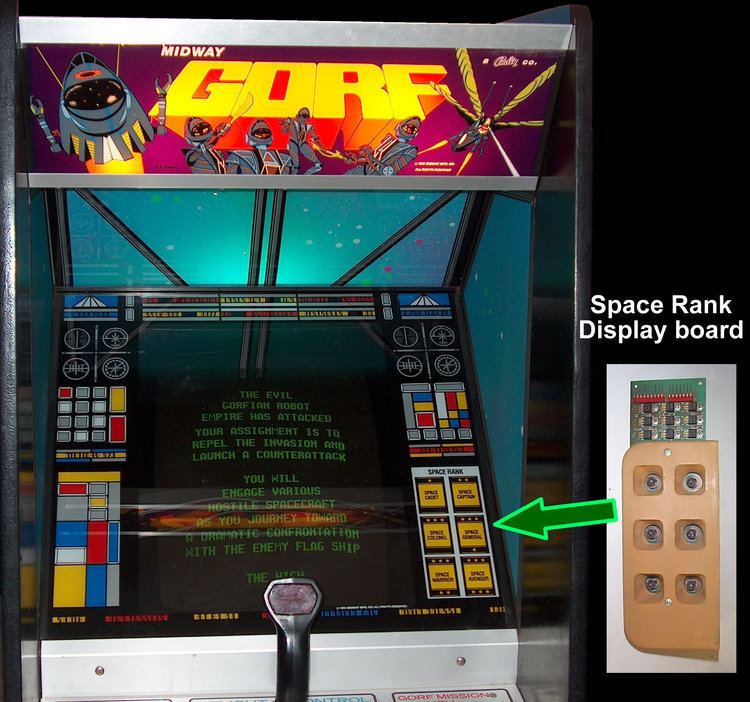Initial release date 1981 | Genre Shoot 'em up | |
 | ||
Mode(s) Up to 2 players, alternating turns Cabinet Upright, cabaret, cocktail Display Raster, 19" monitor (upright & cocktail), 13" (cabaret) Platforms Arcade game, Commodore 64, Atari 2600, ColecoVision, Commodore VIC-20, Atari 5200, Atari 8-bit family, BBC Micro Developers Midway Games, CBS Electronics, Bally Midway Manufacturing Co., Inc., Dave Nutting Associates Publishers Midway Games, CBS Electronics Similar Midway games, Shoot 'em up games | ||
Arcade game gorf 1981 midway
Gorf is an arcade game released in 1981 by Midway Mfg., whose name was advertised as an acronym for "Galactic Orbiting Robot Force". It is a multiple-mission fixed shooter with five distinct modes of play, essentially making it five games in one. It is well known for its use of synthesized speech, a new feature at the time.
Contents

Gorf's most notable feature is its robotic synthesised speech, powered by the Votrax speech chip. One of the first games to allow the player to buy additional lives before starting the game, Gorf allows the player to insert extra coins to buy up to seven starting lives.

The underlying hardware platform for Gorf allowed arcade operators to easily swap the pattern, CPU, and RAM boards with other similar games, such as Wizard of Wor. Only the game logic and ROM boards are specific to each game.

Gameplay

The player controls a spaceship that can move left, right, up and down around the lower third of the screen. The ship can fire a single shot (called a "quark laser" in this game), which travels vertically up the screen. Unlike similar games, where the player cannot fire again until the existing shot has disappeared, the player can choose to fire another shot at any time; if the previous shot is still on screen, it disappears.
Gorf consists of five distinct "missions", each with its own patterns of enemies. The central goal of each mission is to destroy all enemies in that wave, which takes the player to the next mission. Successfully completing all five missions will increase the player's rank and loop back to the first mission, where play continues on a higher difficulty level. The game continues until the player loses all their lives. The player can advance through the ranks of Space Cadet, Space Captain, Space Colonel, Space General, Space Warrior, and Space Avenger, with a higher difficulty level at each rank. Along the way, a robotic voice heckles and threatens the player, often calling the player by their current rank (for example, "Some galactic defender you are, Space Cadet!"). Some versions also display the player's current rank via a series of lit panels in the cabinet.
These are the missions:
- Astro Battles: The first mission is almost an exact clone of Space Invaders. This is the only mission that is not set in space, but rather against a sky-blue background. A small force of enemies (24 in Gorf vs. 55 in Space Invaders) attacks in the classic pattern set by the original game. The player is protected by a glittering parabolic force field that is gradually worn away by enemy fire. The force field switches off temporarily while the player's shots pass through it.
- Laser Attack: In this mission, the player must battle two formations of five enemies each. Each formation contains three yellow enemies that attempt to dive-bomb the player, a white gun that fires a single laser beam, and a red miniature version of the Gorf robot.
- Galaxians: This mission is a clone of Galaxian, with the key differences being the number of enemies (24 in Gorf vs. 46 in Galaxian) and the way the enemies fire (pellets in Gorf, missiles in Galaxian). Gameplay is otherwise similar to the original game.
- Space Warp: Mission 4 places the player in a sort of wormhole, where enemies fly outward from the center of the screen and attempt to either shoot down or collide with the player's ship. It is possible to shoot enemy shots in this level.
- Flag Ship: The Flag Ship is protected by its own force field (similar to the one protecting the player in Mission 1), and it flies back and forth and fires at the player. To defeat it, the player must break through the force field and destroy the ship's core: if a different part of the ship is hit the player receives bonus points and the part breaks off and flies in a random direction, potentially posing a risk to the player's ship. If the player successful hits the Flag Ship's core, the Flag Ship explodes in a dramatic display, the player advances to the next rank, and play continues on Mission 1, with the difficulty increased.
History
Gorf was originally intended to be a tie-in with Star Trek: The Motion Picture, but when the game designers read the film's script, they realized that the concept would not work as a video game. The player's ship resembles the Starship Enterprise.
Sequel
A planned sequel, Ms. Gorf, was never released. It was programmed in the programming language Forth. The source code for the prototype is owned by Gorf programmer Jamie Fenton. The game exists only as source code stored on a set of 8-inch floppy disks, is difficult to retrieve, and would require access to a development environment that no longer exists in order to compile it into executable machine code.
Ports
Gorf was ported to the Atari 2600, Atari 5200, and ColecoVision game consoles and the Atari 8-bit family, Commodore 64, and VIC-20 personal computers in 1982. Due to copyright issues, the Galaxians mission was removed from all ports.
Reception
Video Games stated that the Atari 2600 version of Gorf "truly is a dog", criticizing both gameplay and graphics. This version of the game received a Certificate of Merit in the category of "Best Solitaire Video Game" at the 4th annual Arkie Awards, and received the "1984 Best Computer Game Audio-Visual Effects" award at the 5th Arkies the following year. At the 5th Arkies the judges pointed out that the Atari versions had out-polled both the ColecoVision and Commodore 64 versions of the game, and they suggested that it is the game's "varied action" that "keeps players coming back again and again."
Regarding the VIC-20 version, Electronic Games wrote that "this fast-moving colorful entry is a must ... one of the best games available for the VIC-20", and Ahoy! stated that the VIC-20 version "still has my vote for the best of the bunch ... The graphics are excellent".
Competitive play
On July 17, 2011, Keith Swanson set a new Gorf world record score of 1,129,660 points, recognized by Twin Galaxies. His game spanned 826 missions across 6.5 hours. Swanson is the first person to ever score one million points on 3 ship settings. The previous world record was set by John McCann in 2009 with a score of 943,580.
